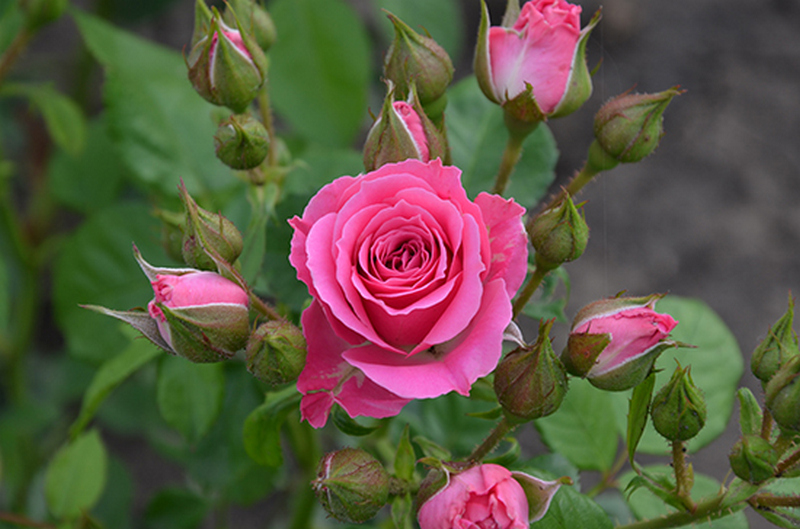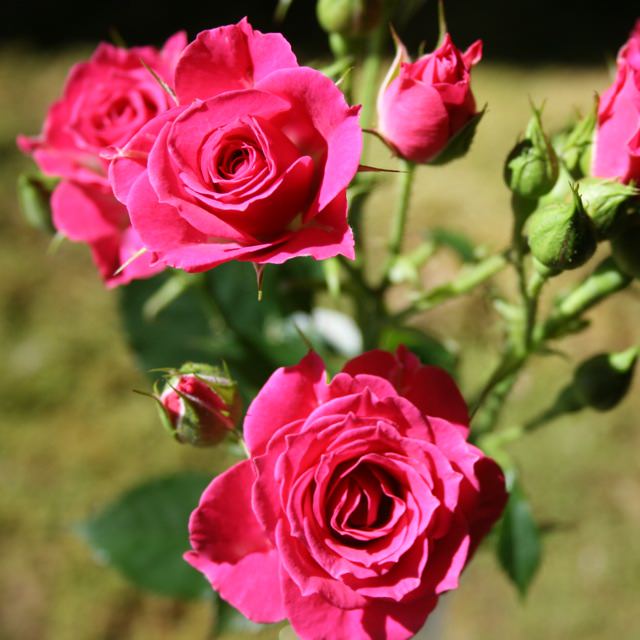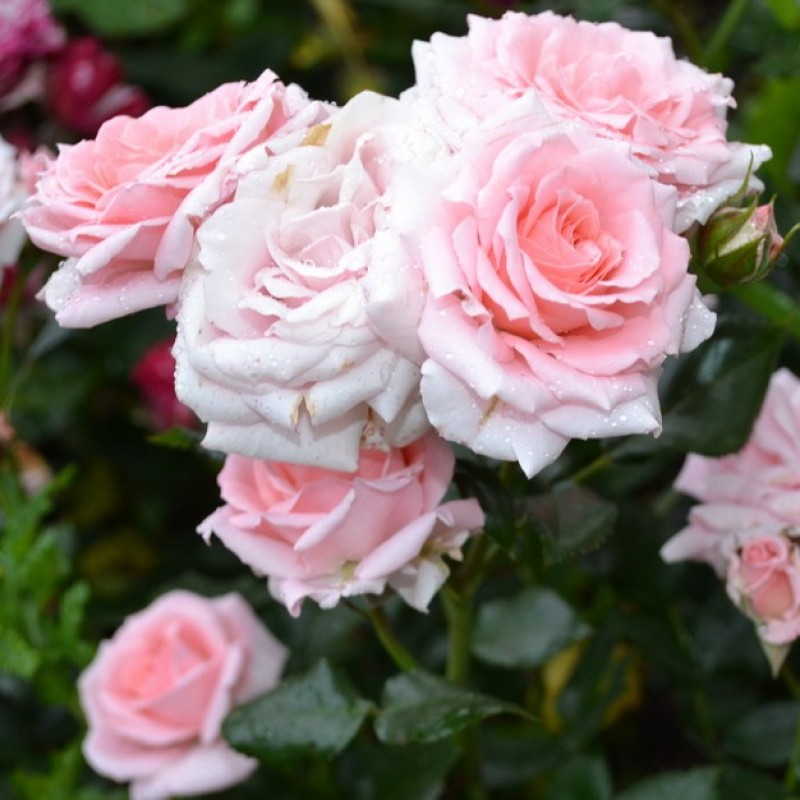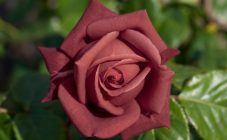Content:
Bush rose Lydia has earned popularity for its pale pink (white) half-open miniature buds. Due to the varietal characteristics, the buds of the Lydia rose acquire a rich pink color in cool weather, the flowering itself continues until late autumn (the first frost).
Description of culture
Rose Lydia (Lydia) bred by G. Peter Islink in the Netherlands in 1995. The variety belongs to the spray rose group, and also belongs to the Floribunda group according to varietal characteristics (low bushes, a large number of inflorescences, abundant flowering in large rosettes).
The bush is compact, low - up to 60 cm. The leaves are regular oval, dark green in color. There are no thorns. The flowers are large (up to 4-5 cm in diameter), collected in rosette inflorescences (up to 10-12 buds per inflorescence). The color and intensity of the color depend on the sub-varietal characteristics. The abundance and duration of flowering depend on the fertility of the soil, quality and proper care, timely watering, treatments, preventive measures in the fight against pests.
Differs in stable immunity to the main diseases of roses (powdery mildew, late blight) and insect pests.
Overview of popular species
The Lydia variety includes 3 main subspecies.
Rose Lovely Lydia
This is one of the most common subspecies of the Lydia cultivar. A low bush (up to 60 cm) with an abundance of beautiful buds, up to 4 cm in diameter.
Rose Floribunda Love Lydia blooms in buds from a delicate creamy pink color to rich crimson. Under the scorching rays of the sun, the flowers fade, which manifests itself in the form of a decrease in the color intensity. The blooming flower has a black core - this is one of the varietal features of the Floribunda lovely lydia rose subspecies.
Differs in especially abundant and long flowering when planted in fertile soil and competent care (removal of dry peduncles, pruning of long branches, regular watering with settled water with the addition of mineral fertilizers). For better growth and flowering, the rose bush Lovely (Lovely) Lydia needs to mulch the soil in the root zone with organic fertilizers (household plant waste, freshly cut hay, straw, spruce branches, chopped bark of fruit trees).
It is recommended to plant seedlings in the spring, when the threat of soil frosts has completely passed in a well-lit area in light partial shade. In a dug hole, measuring 40 cm x 40 cm and a depth of 30 cm, add sand, organic fertilizers (rotted humus, peat), mineral fertilizers (phosphorus-potassium), you can add a handful of chopped oak bark. Then plant a seedling, bury, compact the soil and water abundantly. For landscaping the garden, it is recommended to plant a composition of 5-7 bushes. Perfect for border planting, as well as for landscaping balconies and loggias when grown in containers.
Rose Spray Lovely has a high resistance to diseases of roses such as powdery mildew, late blight, brown spot, gray rot, rust.
It is recommended to timely remove dried flower stalks thickening the middle of the shoots bush, forming a crown for better ventilation.
Of the pests, bushes can be affected by aphids, spider mites, thrips.
An excellent means of pest control is the treatment with an acaricidal-insecticidal preparation (Aktara, Aktellik, Fitoverm, Intavir, etc.).
Carrying out preventive measures helps to prevent the development of diseases and damage by pests. Such measures are: removing and burning dry shoots and leaves in the fall, loosening the soil after each watering to prevent moisture stagnation, treating the soil from pests, moderate watering as needed, timely processing of all bushes when pests appear.
Rose Spray White Lydia
This is one of the subspecies of the Lydia variety. The compactness and mobility of the flower allows you to plant it in containers and decorate the garden, balconies, loggias, terraces. High frost resistance allows growing in the northern regions of Russia.
A compact shrub up to 50 cm high with inflorescences of 12-15 buds of delicate white color, 3-6 cm in diameter, with a weak aroma. When the buds are fully opened, a dark core opens. The leaves are dark green, glossy. Elastic stems without thorns.
For planting, you need to choose a well-lit place without the scorching rays of the sun and drafts. Saplings are planted in central Russia, the Urals, Siberia in April-early May, when the threat of frost is completely over. In the southern regions, seedlings can be planted in September-October. Saplings are planted at a distance of 50 cm from each other. A drainage layer (expanded clay, small pebbles and shells, coarse sand), rotted cow manure (or peat) are poured into a hole 30 cm deep, a seedling is installed and covered with earth. From above, the soil is tamped, watered abundantly and mulched.
Rose Floribunda White Lydia is unpretentious in cultivation and care. The main care consists in regular watering, loosening the soil (to prevent the development of fungal diseases). Particular attention should be paid to plants in wet rainy weather, as high humidity can contribute to the development of fungal diseases (brown spot, powdery mildew, etc.). To prevent them, it is recommended to carry out preventive spraying with a solution of copper sulfate, Bordeaux liquid.
Competent formative pruning with the removal of thickening branches, dry stems and peduncles promotes continuous abundant and prolonged flowering with the onset of warmth and until the first frost.
The variety is resistant to pests. However, under unfavorable growing conditions, it is possible to infest aphids, spider mites, thrips. To combat them, the entire bush must be treated with an acaricide-insecticidal preparation (Aktellik, Aktara, Fitoverm, etc.). Spraying with a strong infusion of a decoction of wormwood and nettle has a positive effect.
Rose Floribunda Classic Lydia
It is a shrub plant, up to 60 m high and up to 50 cm in diameter. The buds are medium in size, up to 3 cm in diameter, of a delicate pink shade, collected in inflorescences (usually up to 10-12 buds). Leaves are dark green, smooth shoots with sparse thorns or their complete absence. It grows and blooms well on fertile soils and a brightly lit area.
Classic Lydia is picky about watering - with a lack or excess of moisture, it sheds buds, the leaves wither. The subspecies is very resistant to diseases of roses and pests. As a rule, insect pests appear with improper care. Diseases can appear in an unfavorable neighborhood with weeds and plants affected by fungal infections.
Rose care Lydia Classic is reduced to:
- Formative pruning in the spring and sanitary pruning in the fall after flowering,
- Regular watering,
- Fertilization during intensive flowering, timely removal of dry peduncles, shoots, wilted leaves,
- Preventive treatments against pests (acaricidal, insecticidal) and rose diseases (fungicidal).
Cuttings
The Lydia variety propagates well by cuttings (regardless of the subspecies and their characteristics). For reproduction, a stalk is taken from the lower shoots with its own well-developed root system and 2 or 4 pairs of true leaves. The stem of the cutting must be cut at an angle of 45 °, kept in Kornevin's solution (growth stimulant) for 2 hours and planted in a light substrate (peat, sand). Cover the top with a plastic bag, periodically removing it to harden the sprout. The best period for propagation by cuttings is from May to August. Already in spring, you can carry out the first pruning, leaving the most developed shoots with 2-3 developed buds and shortening them to a length of 15-20 cm.
Thanks to the varietal subspecies of Floribunda, Lydia blooms with inflorescences from white to creamy pink and deep crimson. Compliance with agrotechnological recommendations during planting contributes to abundant and long flowering from mid-April to the first frost.















